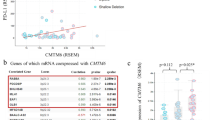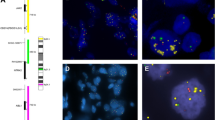Abstract
Pleomorphic xanthoastrocytoma (PXA) is a rare tumor ranging from World Health Organization (WHO) grades 2–3 and can potentially recur and metastasize throughout the central nervous system (CNS). Cyclin-dependent kinase inhibitor 2A/B (CDKN2A/B) deletion is a frequent genomic alteration of PXA. Methylthioadenosine phosphorylase (MTAP) immunohistochemistry is a promising surrogate marker for CDKN2A homozygous deletion in different cancers but has not been examined in PXA. Therefore, we performed CDKN2A fluorescence in situ hybridization and MTAP immunohistochemistry on specimens from 23 patients with CNS WHO grades 2 (n = 10) and 3 (n = 13) PXAs, including specimens from primary and recurrent tumors, and determined whether MTAP immunohistochemistry correlated with CDKN2A homozygous deletion and clinicopathological features. CDKN2A homozygous deletion was detected in 30% (3/10) and 76.9% (10/13) of CNS WHO grades 2 and 3 PXAs, respectively. In addition, MTAP loss was inconsistent with CDKN2A homozygous deletion (sensitivity = 86.7%, specificity = 100%). Furthermore, CDKN2A homozygous deletion was correlated with WHO grade (p = 0.026) and the Ki-67 labeling index (p = 0.037). Therefore, MTAP immunostaining can be a suitable surrogate marker for CDKN2A homozygous deletions in PXAs, and CDKN2A homozygous deletions may be an important prognostic factor for PXAs.





Similar content being viewed by others
Data availability statement
The datasets used and/or analyzed during the current study are available from the corresponding author on reasonable request.
References
Shaikh N et al (2019) Pleomorphic xanthoastrocytoma: a brief review. CNS Oncol 8(3):Cns39
Kepes JJ, Rubinstein LJ, Eng LF (1979) Pleomorphic xanthoastrocytoma: a distinctive meningocerebral glioma of young subjects with relatively favorable prognosis. A study of 12 cases. Cancer 44(5):1839–1852
Phillips JJ et al (2019) The genetic landscape of anaplastic pleomorphic xanthoastrocytoma. Brain Pathol 29(1):85–96
Vaubel R et al (2021) Biology and grading of pleomorphic xanthoastrocytoma-what have we learned about it? Brain Pathol 31(1):20–32
Ryall S, Tabori U, Hawkins C (2020) Pediatric low-grade glioma in the era of molecular diagnostics. Acta Neuropathol Commun 8(1):30
Hida T et al (2017) Immunohistochemical detection of MTAP and BAP1 protein loss for mesothelioma diagnosis: comparison with 9p21 FISH and BAP1 immunohistochemistry. Lung Cancer 104:98–105
Krasinskas AM et al (2010) CDKN2A and MTAP deletions in peritoneal mesotheliomas are correlated with loss of p16 protein expression and poor survival. Mod Pathol 23(4):531–538
Purkait S et al (2013) CDKN2A deletion in pediatric versus adult glioblastomas and predictive value of p16 immunohistochemistry. Neuropathology 33(4):405–412
Cottone L et al (2020) Frequent alterations in p16/CDKN2A identified by immunohistochemistry and FISH in chordoma. J Pathol Clin Res 6(2):113–123
Illei PB et al (2003) Homozygous deletion of CDKN2A and codeletion of the methylthioadenosine phosphorylase gene in the majority of pleural mesotheliomas. Clin Cancer Res 9(6):2108–2113
Ladanyi M (2005) Implications of P16/CDKN2A deletion in pleural mesotheliomas. Lung Cancer 49(Suppl 1):S95–S98
Berg KB et al (2018) Utility of methylthioadenosine phosphorylase compared with BAP1 immunohistochemistry, and CDKN2A and NF2 fluorescence in situ hybridization in separating reactive mesothelial proliferations from epithelioid malignant mesotheliomas. Arch Pathol Lab Med 142(12):1549–1553
Kinoshita Y et al (2018) A combination of MTAP and BAP1 immunohistochemistry is effective for distinguishing sarcomatoid mesothelioma from fibrous pleuritis. Lung Cancer 125:198–204
Chapel DB et al (2020) MTAP immunohistochemistry is an accurate and reproducible surrogate for CDKN2A fluorescence in situ hybridization in diagnosis of malignant pleural mesothelioma. Mod Pathol 33(2):245–254
Barbarino M et al (2020) PRMT5 silencing selectively affects MTAP-deleted mesothelioma: in vitro evidence of a novel promising approach. J Cell Mol Med 24(10):5565–5577
Satomi K et al (2021) Utility of methylthioadenosine phosphorylase immunohistochemical deficiency as a surrogate for CDKN2A homozygous deletion in the assessment of adult-type infiltrating astrocytoma. Mod Pathol 34(4):688–700
Sasaki S et al (2022) Correlation of MTAP immunohistochemistry with CDKN2A status assessed by fluorescence in situ hybridization and clinicopathological features in CNS WHO grade 2 and 3 meningiomas: a single center cohort study. J Neuropathol Exp Neurol 81(2):117–126
Villa C et al (2018) The 2016 World Health Organization classification of tumours of the central nervous system. Presse Med 47(11–12 Pt 2):e187–e200
Louis DN et al (2021) The 2021 WHO classification of tumors of the central nervous system: a summary. Neuro Oncol 23(8):1231–1251
Cheng YY et al (2020) CDKN2A and MTAP are useful biomarkers detectable by droplet digital PCR in malignant pleural mesothelioma: a potential alternative method in diagnosis compared to fluorescence in situ hybridisation. Front Oncol 10:579327
Vaubel RA et al (2018) Recurrent copy number alterations in low-grade and anaplastic pleomorphic xanthoastrocytoma with and without BRAF V600E mutation. Brain Pathol 28(2):172–182
Weber RG et al (2007) Frequent loss of chromosome 9, homozygous CDKN2A/p14(ARF)/CDKN2B deletion and low TSC1 mRNA expression in pleomorphic xanthoastrocytomas. Oncogene 26(7):1088–1097
Zou H et al (2019) Molecular features of pleomorphic xanthoastrocytoma. Hum Pathol 86:38–48
Lassaletta A et al (2017) Therapeutic and prognostic implications of BRAF V600E in pediatric low-grade gliomas. J Clin Oncol 35(25):2934–2941
Shirahata M et al (2018) Novel, improved grading system(s) for IDH-mutant astrocytic gliomas. Acta Neuropathol 136(1):153–166
Dias-Santagata D et al (2011) BRAF V600E mutations are common in pleomorphic xanthoastrocytoma: diagnostic and therapeutic implications. PLoS One 6(3):e17948
Schindler G et al (2011) Analysis of BRAF V600E mutation in 1,320 nervous system tumors reveals high mutation frequencies in pleomorphic xanthoastrocytoma, ganglioglioma and extra-cerebellar pilocytic astrocytoma. Acta Neuropathol 121(3):397–405
Chamberlain MC (2013) Salvage therapy with BRAF inhibitors for recurrent pleomorphic xanthoastrocytoma: a retrospective case series. J Neurooncol 114(2):237–240
Brown NF et al (2017) Dabrafenib and trametinib in BRAFV600E mutated glioma. CNS Oncol 6(4):291–296
Ida CM et al (2015) Pleomorphic xanthoastrocytoma: natural history and long-term follow-up. Brain Pathol 25(5):575–586
Kaley T et al (2018) BRAF inhibition in BRAF(V600)-mutant gliomas: results from the VE-BASKET study. J Clin Oncol 36(35):3477–3484
Nakajima T et al (2006) Malignant transformation of pleomorphic xanthoastrocytoma. Acta Neurochir (Wien) 148(1):67–71 (discussion 71)
Marton E et al (2007) Malignant progression in pleomorphic xanthoastrocytoma: personal experience and review of the literature. J Neurol Sci 252(2):144–153
Tanaka S et al (2014) Epithelioid glioblastoma arising from pleomorphic xanthoastrocytoma with the BRAF V600E mutation. Brain Tumor Pathol 31(3):172–176
Louis D, Ohkagi H, Wiestler O, Cavenee WK (2016) World Health Organization classification of tumours of the central nervous system. World Health Organization classification of tumours revised 4th edition
Louis DN, Prry A, Wesseling P, Brat DJ, Cree IA et al (2021) The 2021 WHO classification of tumors of the central nervous system. World Health Organization classification of tumours revised 5th edition
Savola S et al (2007) Microdeletions in 9p21.3 induce false negative results in CDKN2A FISH analysis of Ewing sarcoma. Cytogenet Genome Res 119(1–2):21–26
Chapel DB et al (2021) Correlation of methylthioadenosine phosphorylase (MTAP) protein expression with MTAP and CDKN2A copy number in malignant pleural mesothelioma. Histopathology 78(7):1032–1042
Rao LS, Miller DC, Newcomb EW (1997) Correlative immunohistochemistry and molecular genetic study of the inactivation of the p16INK4A genes in astrocytomas. Diagn Mol Pathol 6(2):115–122
Funding
The project was supported by Hebei Natural Science Foundation (H2019206709), the Medical Applicable Technology Tracking Project of Hebei (G2018037) and the Second Hospital of Hebei Medical University Foundation (2HC202128).
Author information
Authors and Affiliations
Contributions
LL and YH conceived and designed the study; MM, XX, JJ, and WL performed developed methodology and wrote, reviewed, and revised the paper; LL, JJ and XX acquired, analyzed, and interpreted data and performed statistical analysis; JJ provided technical and material support. All authors read and approved the final paper.
Corresponding author
Ethics declarations
Conflict of interest
The authors declare that they have no conflict of interest.
Additional information
Publisher's Note
Springer Nature remains neutral with regard to jurisdictional claims in published maps and institutional affiliations.
Rights and permissions
Springer Nature or its licensor (e.g. a society or other partner) holds exclusive rights to this article under a publishing agreement with the author(s) or other rightsholder(s); author self-archiving of the accepted manuscript version of this article is solely governed by the terms of such publishing agreement and applicable law.
About this article
Cite this article
Lou, L., Li, J., Qin, M. et al. Correlation of MTAP immunohistochemical deficiency with CDKN2A homozygous deletion and clinicopathological features in pleomorphic xanthoastrocytoma. Brain Tumor Pathol 40, 15–25 (2023). https://doi.org/10.1007/s10014-022-00447-0
Received:
Accepted:
Published:
Issue Date:
DOI: https://doi.org/10.1007/s10014-022-00447-0




